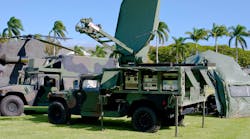RFoF Signals: Unlimited Capabilities for the Connected Battlefield
The number of connected devices around the world is growing exponentially—25 billion of them are predicted by 2025, according to research company Gartner. The number of devices connected within the defense industry is also growing rapidly with diagnostic and situational awareness platforms all becoming smarter. This growth is bringing with it the ability to improve military effectiveness through greater connectivity and access to information and intelligence.
As a result, the integration of C4ISR (Command, Control, Communications, Computer, Intelligence, Surveillance, and Reconnaissance) applications is providing unprecedented advances in military capabilities. Critical to the performance of these applications is the communications network, which is relied on to provide secure, reliable, and robust connectivity that does not fail mission-critical communications.
The Connected Battlefield
Thanks to the integration of C4ISR applications, the military has gained a competitive advantage with improved decision-making and allocation of resources. Integral to achieving this is the process of data transference between the command, communication, and control systems to collect the information needed from a variety of sources. The data collected enables the military to observe, decide, and act effectively. Any limitation in connectivity will reduce the quality and timeliness of the data provided as well as the quality of the decision-making process. The performance of network connectivity is critical to the C4ISR system and making mission-critical decisions.
Critical Connectivity
With massive amounts of information passing across the network to power systems and operations, it’s critical for the network to deliver high bandwidth and speed capabilities. Any interruption or delay in connection weakens the system and the critical performance of the military. To facilitate data sharing, many entities and systems must be integrated and connected to advance intelligence and operational planning capabilities to deliver an advantageous connected battlefield (see figure).
High bandwidth and speed are critical factors for network success.
The geographic areas of the battlefield are large and can span a whole nation. Therefore, the data must efficiently transmit across far distances in real time for command and control systems to execute a perfectly timed decision. As the core architectures remain RF (i.e., antenna and receiver), the demand for an appropriate convergence of technologies has never been greater.
Connectivity Without Limits
Transmitting RF over fiber (RFoF) allows the defense industry to expand the capacity and speed of its network beyond current constraints in the various theatres. In RFoF systems, electro-optical (EO) converters are used to convert RF to optical at the signal source. This signal is then transmitted across single-mode optical fiber to the destination where optical-electro (OE) converters convert it back into RF.
Key to this conversion is that the inherent analog characteristics of the RF signal are not altered during the conversion process. The result is that RFoF can provide greater bandwidth and speed for mission-critical data processing.
Winning with RFoF
The main advantages of using optical fiber include extremely low transmission losses and immunity to electromagnetic, radio, or other types of signal interference essential for military operations. It’s also integral for the military to have unlimited bandwidth at their disposal. Optical fiber allows the signals to span much greater distances integral for battlefields that span vast geographical locations. Since optical fibers are light in weight, they also support weight-sensitive and rapid deployment-focused applications.
Another vital factor in the performance of C4ISR applications is robust network security. Optical fibers feature a high level of security from the antenna to the receiver end, making them much more difficult to tap. With optical fiber, any disturbance is much easier to detect, locate, and prevent from becoming a security threat, which is a priority for mission-critical communication.
In addition, optical fibers can transfer any frequency, any data rate, and/or any modulation format both today and in the future, providing the military with a network they can use to distribute different signal types through the same fiber infrastructure. This creates a flexible network that can be adapted to future military commands. The same infrastructure can also be used without any need for an upgrade, saving time and money. Overall, RFoF is able to provide the military with improved security, performance, readiness, and resilience at lower overall costs.
Building a Resilient Network Infrastructure
HUBER+SUHNER has been meeting the needs of mission-critical applications in some of the most rugged environments for over 15 years. The company understands that end-to-end RFoF systems are ultimately required to achieve the performance, stability, and reliability requirements of defense applications. This has led to the HUBER+SUHNER Polatis ultra-reliable all-optical switching solution, which delivers the specifications and features required to achieve maximum signal integrity throughout the system.
A Connected Battlefield for the Future
The integration of C4ISR systems into existing platforms is driving RFoF system market growth on a massive scale, and this is set to continue well into the future. The military is looking to shift its focus from organizational and operational concepts to a military service that’s fully integrated with connectivity systems to gather, process, display, and transmit information. This shift will create more opportunities for the military to use the capabilities of C4ISR applications. Critical to such performance is the network infrastructure that they choose to deploy. Using RFoF systems, the military can build a network that has greater resilience and performance, and one that’s more secure at an overall lower cost.
HUBER+SUHNER connectivity solutions for the connected battlefield include both discrete and system-oriented solutions optimized for mission-critical applications. HUBER+SUHNER has worked on innovating the best-in-class RF and fiber-optic components and systems needed for end-to-end RFoF solutions. The HUBER+SUHNER portfolio of defense applications and solutions includes RF cables, connectors, and RF-to-optical transceivers, multiplexers if running different channels on a single fiber, and a host of fiber and RF cable management products.


